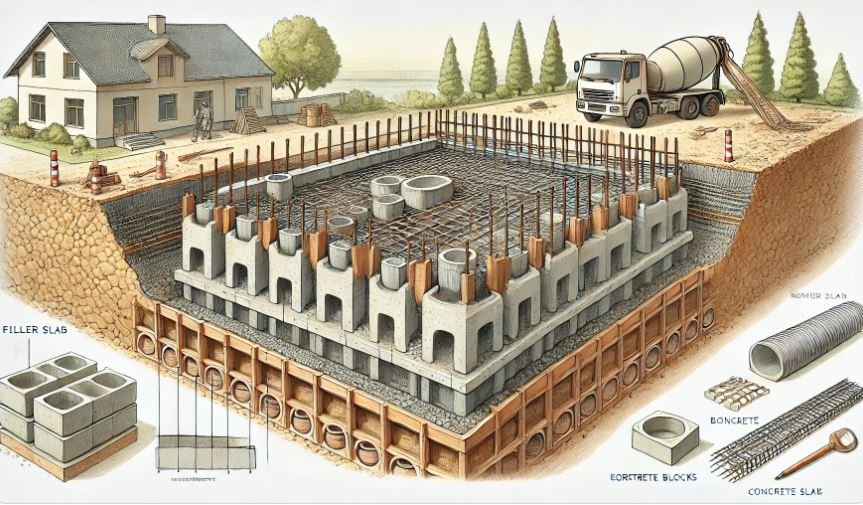Filler Slab: A Practical Guide to an Innovative Roofing Solution

When building or renovating a home, one of the most important decisions revolves around the type of roof you choose. Filler slabs have emerged as a cost-effective and eco-friendly roofing option gaining popularity in modern construction. In this blog post, we’ll dive deep into what filler slabs are, their benefits, and why you might consider them for your next project.
What is a Filler Slab?
A filler slab is a type of roofing construction that replaces part of the concrete in a slab with less expensive or waste materials like clay tiles, hollow bricks, or even empty bottles. This technique not only reduces the amount of concrete and steel used but also makes the structure lighter and more sustainable.
Unlike traditional slabs, filler slabs incorporate a creative design that keeps the structural integrity intact while reducing construction costs and environmental impact. Plus, they look pretty cool, too!
Benefits of Filler Slabs
1. Cost-Effectiveness
- Using filler materials significantly reduces the quantity of concrete and steel required, cutting down construction costs.
- Ideal for budget-conscious homeowners or developers.
2. Eco-Friendly
- By replacing concrete with waste or natural materials, filler slabs reduce the carbon footprint.
- Recycling materials like clay tiles or empty bottles prevents them from ending up in landfills.
3. Thermal Insulation
- Filler materials like clay tiles or hollow bricks provide better insulation, keeping interiors cooler in hot climates.
- This can lead to lower energy bills, especially in tropical regions.
4. Aesthetic Appeal
- The underside of a filler slab can be left exposed, showcasing the pattern of the filler material for a unique architectural look.
- No need for additional ceiling work!
5. Durability
- Despite the reduced concrete and steel, filler slabs are as strong as conventional slabs when properly designed and executed.
Where Can Filler Slabs Be Used?
Filler slabs are versatile and can be used in various types of buildings, such as:
- Residential homes
- Schools and colleges
- Offices
- Community centers
- Farmhouses
They are particularly useful in regions where cost savings and thermal insulation are priorities.
How to Construct a Filler Slab?
Building a filler slab requires expertise and attention to detail. Here’s a simplified process:
- Choose Filler Materials: Decide on the material based on availability, cost, and design preferences (e.g., clay tiles, hollow bricks, or recycled bottles).
- Structural Design: Consult a structural engineer to ensure the slab design meets load-bearing requirements.
- Place Fillers: Arrange the fillers between the reinforcements, ensuring proper alignment.
- Pour Concrete: Carefully pour concrete over the fillers, ensuring even coverage and no voids.
- Curing: Allow sufficient curing time for the slab to gain its full strength.
Challenges of Filler Slabs
While filler slabs are amazing, they come with a few challenges:
- Skilled Labor: Constructing a filler slab requires workers experienced in this technique.
- Initial Planning: Proper planning and design are crucial to ensure safety and durability.
- Availability of Materials: Depending on your location, finding suitable filler materials might be a challenge.
Conclusion
A filler slab is an innovative and sustainable roofing option that combines functionality, cost savings, and aesthetic appeal. It’s perfect for those looking to build eco-friendly homes without compromising on quality or design. With the right planning and skilled labor, a filler slab can be a game-changer for your construction project.
FAQs about Filler Slabs
Q: Are filler slabs strong enough for multi-story buildings?
Yes, filler slabs can be used in multi-story buildings if designed and executed properly. Always consult a structural engineer for accurate load calculations.
Q: What materials can be used as fillers?
Common fillers include clay tiles, hollow bricks, recycled plastic bottles, coconut shells, and even waste wood.
Q: How much can I save by using filler slabs?
Cost savings vary but can range from 15% to 25% of the total slab cost due to reduced concrete and steel usage.
Q: Can filler slabs be used in cold climates?
Yes, but the choice of filler material should provide adequate insulation for the climate.
Q: Do filler slabs require additional maintenance?
Not at all! They are as durable as conventional slabs and require no extra maintenance.
By incorporating filler slabs into your construction plans, you can save money, reduce environmental impact, and add a touch of creativity to your project. It’s a win-win solution for modern, mindful construction!



